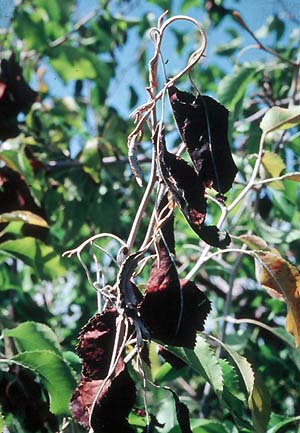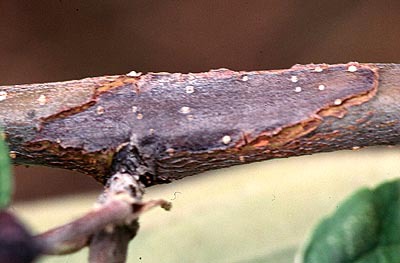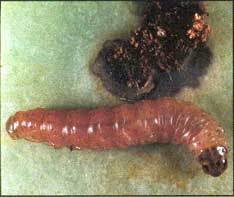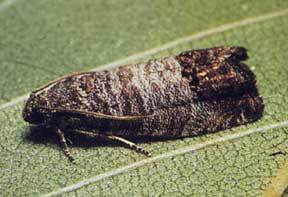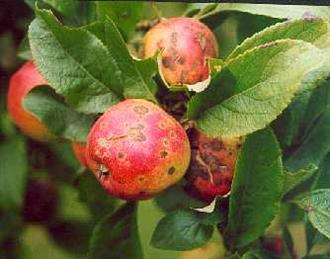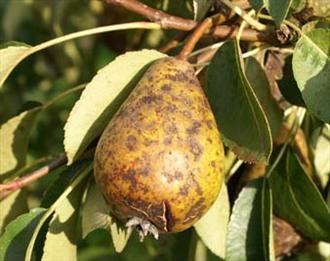
Apple and pear trees:Some apple and pear trees have low chilling requirements and will produce fruit here in Central Texas. The problem is that many of the trees that have low chill requirements also are susceptible to fire blight. If you want to grow apples and pears here, then you must know how to manage fire blight. Fire blight is easy to recognize. It causes the tips of the new growth to wilt and turn brown. The dead foliage hangs onto the tree, including the fruit, making it look like it was scorched by fire, hence the name. It also causes cankers on the branches and trunk. In severe cases it can kill the tree.
Photos courtesy of P. Sholberg
Ministry of Agriculture and Lands, Canada
Ministry of Agriculture and Lands, Canada
Fire blight canker
Fire blight is difficult to manage, for although you monitor your own trees, your neighbors may not, and the wind and insects carries the bacteria. Hawthorns, pyracanthas, blackberries, and ornamental trees such as crab apples and Bradford pear trees are also susceptible, and may become hosts. If fire blight attacked your trees last summer, now is the time while the tree is dormant to prune out the blighted branches 8 - 12 inches below the visible infection, and trim the edges of the cankers. If they cover more than 50% of the circumference of the limb you'll have to cut it off. To trim around the cankers, cut around the dead looking bark a couple of inches away, down to the wood, and scrape out all the bark. Treat the wound with alcohol. It will be necessary to disinfect your cutting tools with bleach while you work if you touch an infected area on the tree with your tools and want to prune other branches, or before you work on another tree, because you will just be spreading the disease. The easiest way to keep your tools clean is to keep a bucket of strong bleach solution nearby, and dip your tools in it as needed.
For more information check see the Ministry of Agriculture and Lands, CA website.
Right before the tree blooms is it is time to spray with a copper spray. Although copper sprays will kill many bacteria residing on the tree, it cannot be used on a flowering tree with young tender leaves, as it will damage the fruit and burn the leaves. This is unfortunate because the tree is actually most vulnerable when it is in bloom. The wind and insects carry the bacteria to the sticky stamens of the flowers and the bacteria enters the stems into the tree. There are few options for organic growers during this time of bloom. Commercial orchards spray flowering trees using streptomycin antibiotic, but fire blight bacteria is beginning to show resistance to it. Other sprays being used are Aluminum tris bactericide, and Pseudomonas fluorescens, strain A 506, a bacteria that slows the growth of fire blight bacteria. Pseudomonas fluorenscens commercial name is 'Blight Ban' but it has only been available to those with a commercial spray license. For a Midwest Fruit Spray Guide check out www.extension.iastate.edu/Publications/PM1282.pdf.
The Coddling moth is the next worst pest on the list that attacks pear and apple trees. Fruit that seems to be growing OK can suddenly begin to fall off the tree before ripening. Upon investigation you'll find codling moth larvae inside the fruit. Again, prevention is the best cure. Spray trees with dormant oil in the late winter to suffocate the eggs before the tree leaves bud. Put codling moth traps out before the tree blooms before any moths hatch out. Keep one trap out per tree, and replace them monthly. Once you find some moths in your traps you'll know that they have become active and it's time to start to spray. In the South, this can happen early when there is a prolonged warm spell. Fortunately, there is a safe effective remedy that organic growers can use also. Make a permethrin solution with some dish soap added to make it stick better, and spray the tree once a week for at least four weeks. If it rains it will wash off the spray, so spray immediately again afterward. This will kill a lot of larva off that may have hatched. Coddling moths don't travel long distances easily, so taking care of your resident codling moths, can really make a difference in having less wormy apples and pears and keeping fruit on the tree until they ripen. Keep the area beneath the tree clean of rotten fruit and that will help next season, too.
Fire blight is difficult to manage, for although you monitor your own trees, your neighbors may not, and the wind and insects carries the bacteria. Hawthorns, pyracanthas, blackberries, and ornamental trees such as crab apples and Bradford pear trees are also susceptible, and may become hosts. If fire blight attacked your trees last summer, now is the time while the tree is dormant to prune out the blighted branches 8 - 12 inches below the visible infection, and trim the edges of the cankers. If they cover more than 50% of the circumference of the limb you'll have to cut it off. To trim around the cankers, cut around the dead looking bark a couple of inches away, down to the wood, and scrape out all the bark. Treat the wound with alcohol. It will be necessary to disinfect your cutting tools with bleach while you work if you touch an infected area on the tree with your tools and want to prune other branches, or before you work on another tree, because you will just be spreading the disease. The easiest way to keep your tools clean is to keep a bucket of strong bleach solution nearby, and dip your tools in it as needed.
For more information check see the Ministry of Agriculture and Lands, CA website.
Right before the tree blooms is it is time to spray with a copper spray. Although copper sprays will kill many bacteria residing on the tree, it cannot be used on a flowering tree with young tender leaves, as it will damage the fruit and burn the leaves. This is unfortunate because the tree is actually most vulnerable when it is in bloom. The wind and insects carry the bacteria to the sticky stamens of the flowers and the bacteria enters the stems into the tree. There are few options for organic growers during this time of bloom. Commercial orchards spray flowering trees using streptomycin antibiotic, but fire blight bacteria is beginning to show resistance to it. Other sprays being used are Aluminum tris bactericide, and Pseudomonas fluorescens, strain A 506, a bacteria that slows the growth of fire blight bacteria. Pseudomonas fluorenscens commercial name is 'Blight Ban' but it has only been available to those with a commercial spray license. For a Midwest Fruit Spray Guide check out www.extension.iastate.edu/Publications/PM1282.pdf.
The Coddling moth is the next worst pest on the list that attacks pear and apple trees. Fruit that seems to be growing OK can suddenly begin to fall off the tree before ripening. Upon investigation you'll find codling moth larvae inside the fruit. Again, prevention is the best cure. Spray trees with dormant oil in the late winter to suffocate the eggs before the tree leaves bud. Put codling moth traps out before the tree blooms before any moths hatch out. Keep one trap out per tree, and replace them monthly. Once you find some moths in your traps you'll know that they have become active and it's time to start to spray. In the South, this can happen early when there is a prolonged warm spell. Fortunately, there is a safe effective remedy that organic growers can use also. Make a permethrin solution with some dish soap added to make it stick better, and spray the tree once a week for at least four weeks. If it rains it will wash off the spray, so spray immediately again afterward. This will kill a lot of larva off that may have hatched. Coddling moths don't travel long distances easily, so taking care of your resident codling moths, can really make a difference in having less wormy apples and pears and keeping fruit on the tree until they ripen. Keep the area beneath the tree clean of rotten fruit and that will help next season, too.
coddling Moth Larvae and Adult
Photos courtesy of MSU
For more information see the fruit pests website of MSU
Another serious pest to take care of in the spring is scab. Scab fungus stunts the fruit and leaves on the tree, and is a serious pest especially for commercial orchards that must have perfect fruit to be able to sell it. It won't hurt you to eat fruit with scab; it just makes the fruit stunted and ugly. It is caused by a fungus that overwinters on infected leaves and old fruit on the ground. Scab is controlled by spraying with sulpher before the buds open. If you wait to spray any later, it will be too late for the season. The scab fungus will have already attacked the flowers, and consequently infect the fruit, too.
For more information see the fruit pests website of MSU
Another serious pest to take care of in the spring is scab. Scab fungus stunts the fruit and leaves on the tree, and is a serious pest especially for commercial orchards that must have perfect fruit to be able to sell it. It won't hurt you to eat fruit with scab; it just makes the fruit stunted and ugly. It is caused by a fungus that overwinters on infected leaves and old fruit on the ground. Scab is controlled by spraying with sulpher before the buds open. If you wait to spray any later, it will be too late for the season. The scab fungus will have already attacked the flowers, and consequently infect the fruit, too.
Photos courtesy of Keepers-Nursery UK
For more info visit the Keepers-Nursery website
There are other diseases of apple and pear trees that are treated during the growing season and fall, so that discussion can take place elsewhere. However, this makes one appreciate the intensive work involved in getting them to your store beautiful and perfect, which is why I buy mine at HEB.
For more info visit the Keepers-Nursery website
There are other diseases of apple and pear trees that are treated during the growing season and fall, so that discussion can take place elsewhere. However, this makes one appreciate the intensive work involved in getting them to your store beautiful and perfect, which is why I buy mine at HEB.
